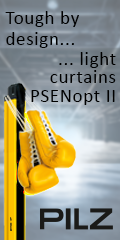
Posted to News on 11th Jan 2007, 22:10
Safe use of motors in hazardous-dust environments
Andy Glover of WEG UK gives some advice on motor specification and application in dusty environments where there is a risk of explosion.
One of the major benefits of the ATEX Directive is the focus that it provides on industrial dust as a potential source of explosions. Almost all types of industrial dust can be considered to be potentially explosive, so it comes as no surprise that the procedure for technical evaluation of safety measures used to avoid the risks of dust explosions is both complex and extensive.
In order to describe the explosion risk posed by dust, a number of factors need to be considered. These include what areas are affected by combustible dust, and the type character and particle size of the dust. Is the dust electrically conductive or non-conductive? Will it build up on the product in layers or be present as a cloud surrounding the product? What is the ignition temperature of the dust? This must be ascertained in order to ensure that motor surface temperatures always remain below that of the explosive mixture.
Once the dust has been characterized, an examination needs to be made of the industrial processes concerned. This takes into account possible ignition sources, explosive volumes, operating temperatures and an assessment of the possibility of a dust explosion under given conditions. Following this risk assessment, the plant areas affected by dust can be classified into zones, each one supported by detailed documentation and inspection schedules to ensure safety compliance. Helpfully for engineers involved in safety evaluations of dust-laden atmospheres, the IEC Standard simplifies explosion protection by classifying risk areas into three zones: 20, 21 and 22.
Zones explained
Zone 20, the most critical of the three, is an area in which an explosive atmosphere in the form of a cloud of combustible dust in air is present continuously, or for long periods, or frequently. Typically, these conditions would be encountered on the inside of containers or pipelines and enclosed conveying equipment.
Zone 21 is a place in which an explosive atmosphere in the form of a cloud of combustible dust in air is likely to occur in normal operation occasionally - for example, when discharging and filling equipment. In this instance, the certification covers both conductive and non-conductive dusts with electric motors obliged to have a minimum protection degree against ingress of solid foreign bodies of IP65.
Zone 22 is a place in which an explosive atmosphere in the form of a cloud of combustible dust in air is not likely to occur in normal operation but, if it does occur, will persist for a short period only. Areas in which dust escapes and forms deposits are included in this category. Here the certification covers non-conductive dusts for motors having minimum ingress protection IP55 and for conductive dusts IP65.
The extremely hazardous nature of Zone 20 means that motors cannot be used there; however, products complying with the ATEX Directive 94/9/EC can be used in Zones 21 and 22. WEG offers high-efficiency dust-ignition-proof motors for use in both of these zones: categories Ex II 2D Ex tD A21 IP65 T125degC (Zone 21) and Ex II 3D Ex tD A22 IP55 T125degC (Zone 22). The WEG Zone 22 motor offers the added benefit of operation in gas Zone 2 (Ex II 3 G EEx nA II T3). This means that one motor type will suffice in atmospheres containing both combustible gas and non-conductive combustible dust. In addition, both WEG Zone 21 and 22 motors are suitable for use with variable speed drives (VSD). The motors benefit from WEG's Class F insulation system (with Class H winding wire as standard), which is highly efficient in dealing with the higher peak voltages and faster voltage rise times generated by the IGBTs (high dV/dt) used in the latest generation of VSD.
Energy efficiency
As well as providing high levels of safeguarding, WEG's DIP ranges incorporate high efficiency machines that either meet or exceed CEMEP/WIMES requirements. Premium Efficiency types meet the requirements of CEMEP's / WIMES EFF1 level, while the Top Premium Efficiency EFF1+ units comfortably exceed these requirements with efficiency levels up to 96.8 per cent.
In addition, WEG also offers EEx d/de high-efficiency motors in premium-efficiency ratings up to 400kW for use in gaseous Zone 1 hazardous environments. All of these motor types are registered with the DEFRA to enable users to claim enhanced capital allowances (ECAs) on the motor purchase – which can make a substantial contribution to reducing payback times.
ATEX-compliant motors from stock
WEG offers the market a comprehensive and graduated range of ATEX-compliant electric motors for use in a wide variety of dust-laden or gaseous atmospheres. In addition to the dust-ignition-proof ranges described above, the following gas-compliant classifications are included in the WEG Low-Voltage product range: EEx d / EEx de IIA, IIB and IIC (explosion proof), EEx nA, (non sparking) and EEx e (increased safety). These offer the user and OEM flexibility in both application specification and cost. Complementing this flexibility is the wide range available: ratings up to 1120kw and frame size 500 - in standard, 2, 4, 6 and 8-pole configurations. Completing the WEG hazardous area offering is a comprehensive range of MV/HV machines in EEx d/EEx de, EEx p and EEx nA variants in multiple polarities and power ratings.
Notes
CEMEP is the European Committee of Manufacturers of Electrical Machines and Power Electronics.
WIMES is the Water Industry Mechanical and Electrical Standard.
DEFRA is the Department of Environment, Food and Rural Affairs.
Want the latest machine building news straight to your inbox? Become a MachineBuilding member for free today >>














